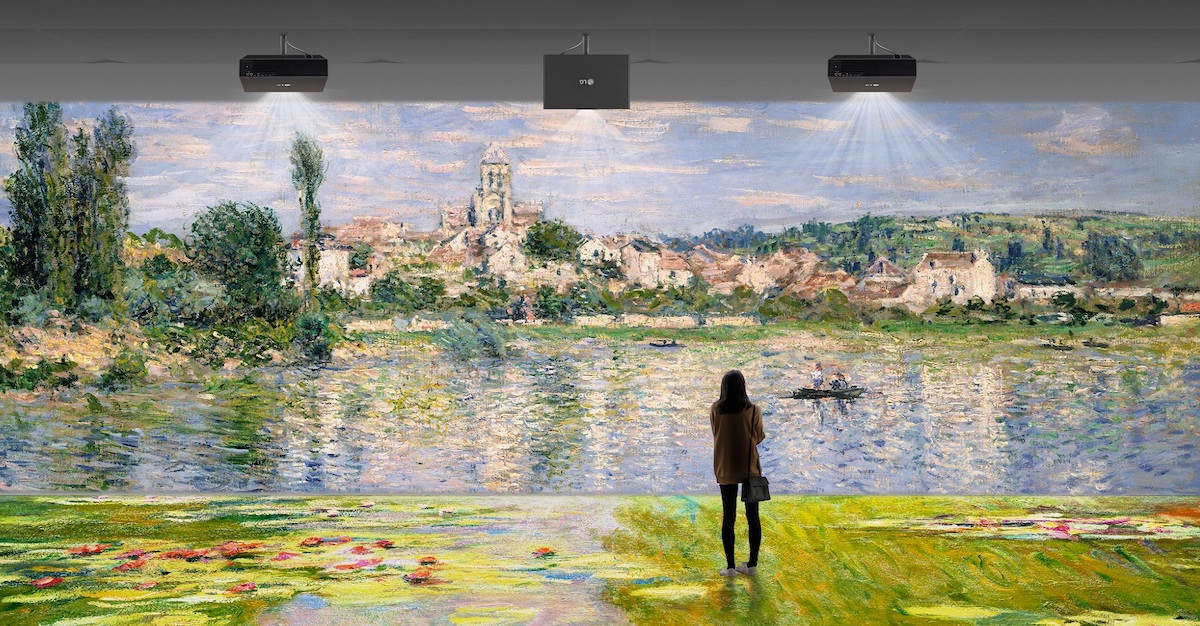
LG Launches “First” Digital Signage-Specific Projector, With Built-in SoC Smarts And webOS Support
March 29, 2023 by Dave Haynes
LG Electronics has taken the interesting step of developing and marketing a new 4K laser, 7,000 lumens projector it says is specifically tuned to the needs of digital signage applications.
LG has been manufacturing and marketing projectors for years, but the main use-cases have been applications like corporate boardrooms and lecture theaters. What’s perhaps interesting and distinct about the new LG ProBeam 4K UHD (model BU70QGA) is that it is brighter than other ProBeams, but also has a System on Chip media player built into the unit, so it can run signage applications without the cost and footprint of a separate, standalone media player.
Says the PR:
Leveraging a high performance SoC (System-on-Chip), the projector can execute several tasks at once, provide smooth content playback and optimize user convenience with an intuitive UI and simple app development tools. The BU70QGA can also connect with LG ConnectedCare; LG’s cloud-based device management solution for LG digital signage and display devices. Equipped with webOS 6.0, the new ProBeam allows third-party providers to add projection capabilities to their offering, expanding the diversity and value of LG’s extensive signage ecosystem.
“Our first 4K digital signage projector to feature the LG webOS 6.0 platform, the new LG ProBeam is a powerful and flexible display solution,” says Seo Young-jae, SVP and head of the IT business unit of LG Electronics Business Solutions Company. “Designed for the commercial sector, LG’s ProBeam projector lineups offer diverse, customized options that can help customers create professional-grade AV systems tailored to their specific needs.”
The projectors are touted as being suitable for environments like art galleries, exhibition spaces, corporate lobbies, retail stores, showrooms, conference halls and auditoriums.
LG ProBeam produces 4K UHD (3,840 x 2,160) resolution pictures with a 3,000,000:1 contrast ratio at sizes ranging from 40 inches all the way up to 300 inches. Its 7,000 ANSI lumens peak brightness enables the BU70QGA to deliver clear images, even in bright daylight. Additionally, the projector features a reliable laser light source, lens shift, 1.6x optical zoom, built-in wireless connectivity and an integrated camera that aids in setup and positioning.
Edge blending technology enables the seamless connection of overlapping light from two or more projectors through luminance adjustment and color correction. Thanks to this advanced tech, up to nine BU70QGA can be used together to create truly panoramic images and an immersive viewing experience. Museums and art galleries, in particular, will find value in the projectors’ ability to provide large, eye-catching images.
Convenient and versatile, the LG ProBeam is a professional-quality video system suitable for various business environments. Using the BU70QGA’s Auto Screen Adjustment feature, users can quickly calibrate the image to the projection screen and correct image distortion with just one click of a button on the included remote controller. When the projection angle does not align with the screen, LG’s AI sensing technology evaluates lens shift, zoom, focus as well as warp distortion and automatically adjusts the projected image for an optimized viewing experience.
The sales sheet and specs suggests LG’s own SuperSign software is what would drive these projectors, but if it runs on webOS, it perhaps can also work with CMS platforms that have developed players for that operating system.
I find this interesting because there’s been so much attention on LED video walls that more established display technologies like projection tend to get overlooked as options for signage projects. I also don’t sense there’s a whole bunch of volume for the projection jobs that do happen. However, projection done well can be pretty awesome – especially when visuals just show up on unexpected surfaces.



How long do you think it will be before we see SOC technology in video wall controllers like the NovaStar 660 line?
Beats me. The teeny form factor and ability to embed right in a display (or projector) is the main attraqction. I am not sure how important that might be with a controller box that sits out of sight.